MITSUBISHI iMiEV 2013 (in English) Owner's Guide
Manufacturer: MITSUBISHI, Model Year: 2013, Model line: iMiEV, Model: MITSUBISHI iMiEV 2013Pages: 258, PDF Size: 13 MB
Page 21 of 258
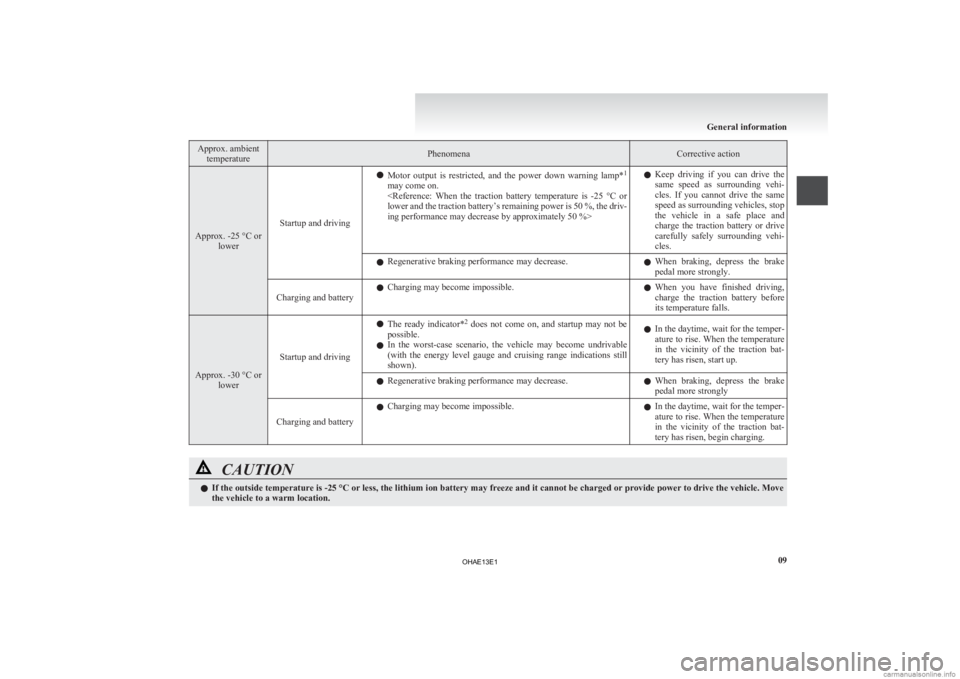
Approx. ambient
temperature Phenomena Corrective action
Approx. -25 °C or
lower Startup and driving l
Motor output is restricted, and the power down warning lamp* 1
may come on.
ing performance may decrease by approximately 50 %> l
Keep driving if you can drive the
same speed as surrounding vehi-
cles. If you cannot drive the same
speed as surrounding vehicles, stop
the vehicle in a safe place and
charge the traction battery or drive
carefully safely surrounding vehi-
cles.
l Regenerative braking performance may decrease.
lWhen
braking, depress the brake
pedal more strongly.
Charging and battery l
Charging may become impossible.
lWhen
you have finished driving,
charge the traction battery before
its temperature falls. Approx. -30 °C or
lower Startup and driving l
The
ready indicator* 2
does not come on, and startup may not be
possible.
l In the worst-case scenario, the vehicle may become undrivable
(with the energy level gauge and cruising range indications still
shown). l
In the daytime, wait for the temper-
ature to rise. When the temperature
in the vicinity of the traction bat-
tery has risen, start up.
l Regenerative braking performance may decrease.
lWhen
braking, depress the brake
pedal more strongly
Charging and battery l
Charging may become impossible.
lIn
the daytime, wait for the temper-
ature to rise. When the temperature
in the vicinity of the traction bat-
tery has risen, begin charging. CAUTION
l
If the outside temperature is
-25 °C or less, the lithium ion battery may freeze and it cannot be charged or provide power to drive the vehicle. Move
the vehicle to a warm location. General information
09
OHAE13E1
Page 22 of 258
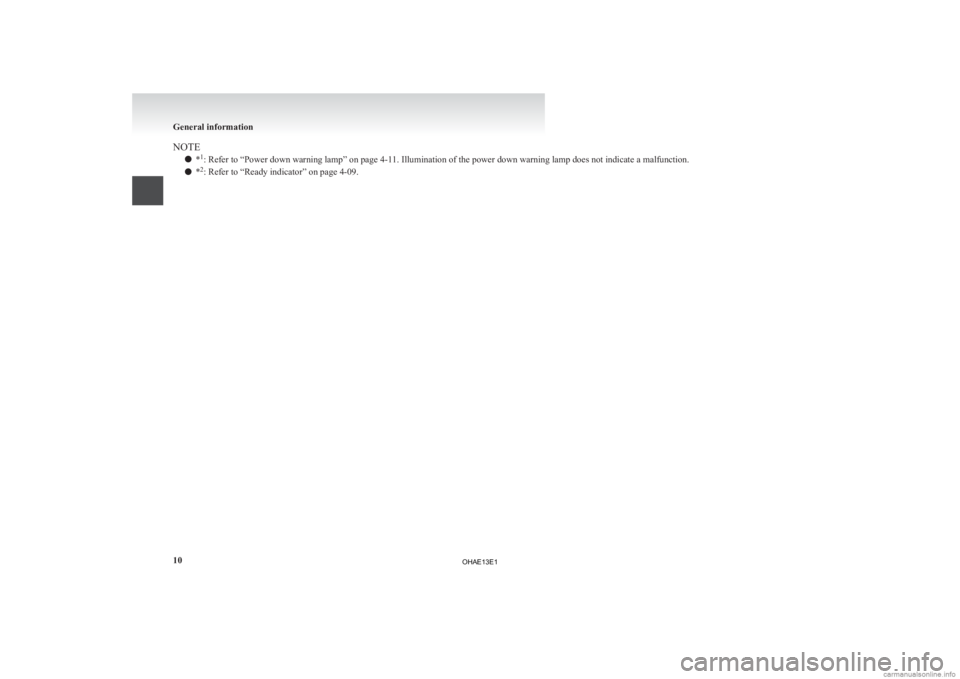
NOTE
l *1
: Refer to “Power down warning lamp” on page
4-11. Illumination of the power down warning lamp does not indicate a malfunction.
l *2
: Refer to “Ready indicator” on page 4-09. General information
10
OHAE13E1
Page 23 of 258
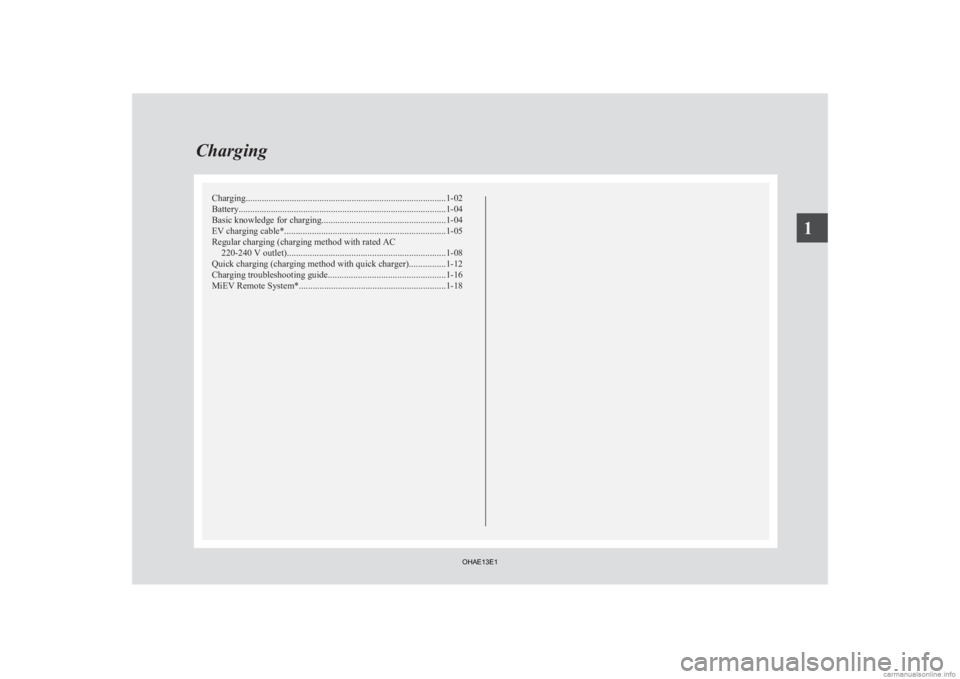
Charging.......................................................................................
1-02
Battery .......................................................................................... 1-04
Basic knowledge for charging ...................................................... 1-04
EV charging cable* ...................................................................... 1-05
Regular charging (charging method with rated AC 220-240 V outlet)..................................................................... 1-08
Quick charging (charging method with quick charger) ................1-12
Charging troubleshooting guide ................................................... 1-16
MiEV Remote System* ................................................................ 1-18Charging
1
OHAE13E1
Page 24 of 258
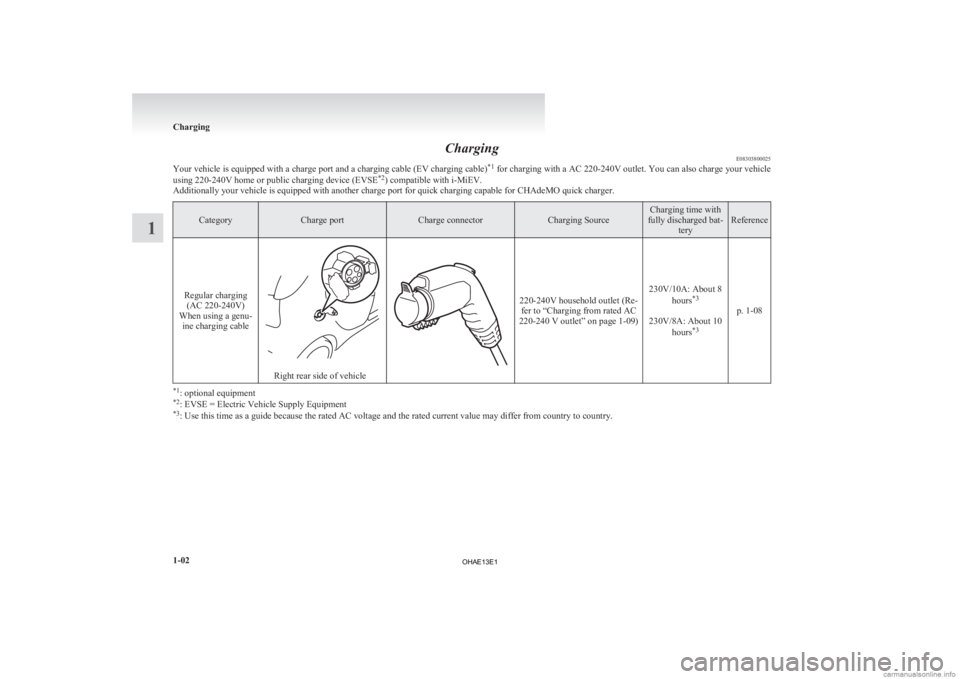
Charging
E08303800025
Your
vehicle is equipped with a charge port and a charging cable (EV charging cable) *1
for charging with a AC 220-240V outlet. You can also charge your vehicle
using 220-240V home or public charging device (EVSE *2
) compatible with i-MiEV.
Additionally your vehicle is equipped with another charge port for quick charging capable for CHAdeMO quick charger. Category Charge port Charge connector Charging Source Charging time with
fully discharged bat- tery Reference
Regular charging (AC 220-240V)
When using a genu- ine charging cable Right rear side of vehicle 220-240V household outlet (Re-
fer to “Charging from rated AC
220-240 V outlet” on page 1-09) 230V/10A: About 8
hours*3
230V/8A: About 10
hours*3 p. 1-08*1
: optional equipment
*2 : EVSE = Electric Vehicle Supply Equipment
*3 : Use this time as a guide because the rated AC voltage and the rated current value may differ from country to country. Charging
1-02
1
OHAE13E1
Page 25 of 258
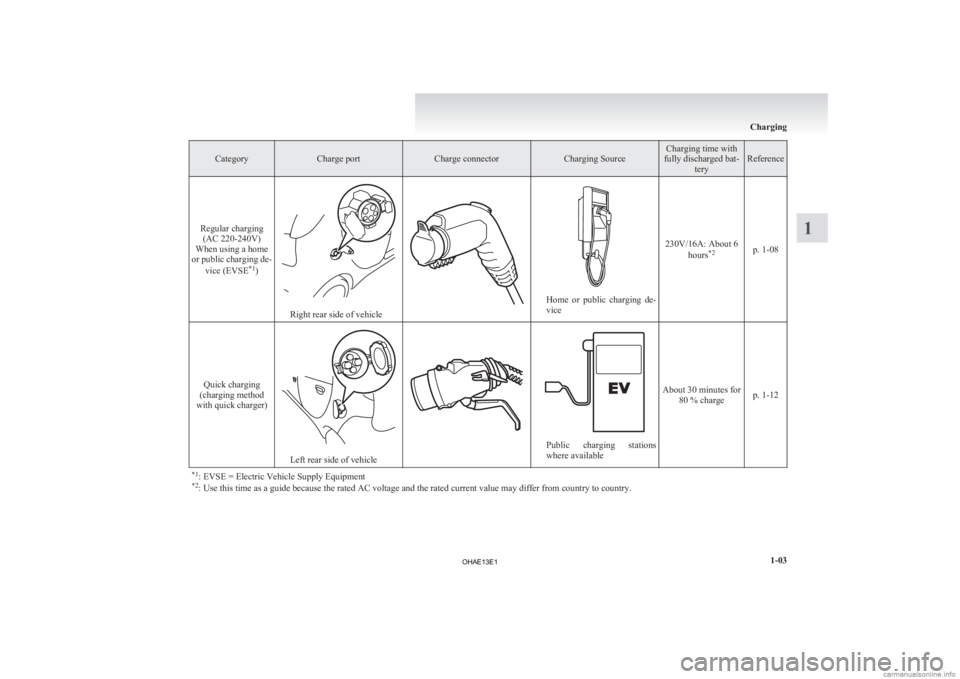
Category Charge port Charge connector Charging Source Charging time with
fully discharged bat- tery Reference
Regular charging (AC 220-240V)
When using a home
or
public charging de- vice (EVSE *1
) Right rear side of vehicle Home or public charging de-
vice
230V/16A: About 6
hours*2
p. 1-08
Quick charging
(charging method
with quick charger) Left rear side of vehicle Public charging stations
where available
About 30 minutes for
80 % charge p. 1-12
*1 : EVSE = Electric Vehicle Supply Equipment
*2 : Use this time as a guide because the rated AC voltage and the rated current value may differ from country to country. Charging
1-03 1
OHAE13E1
Page 26 of 258
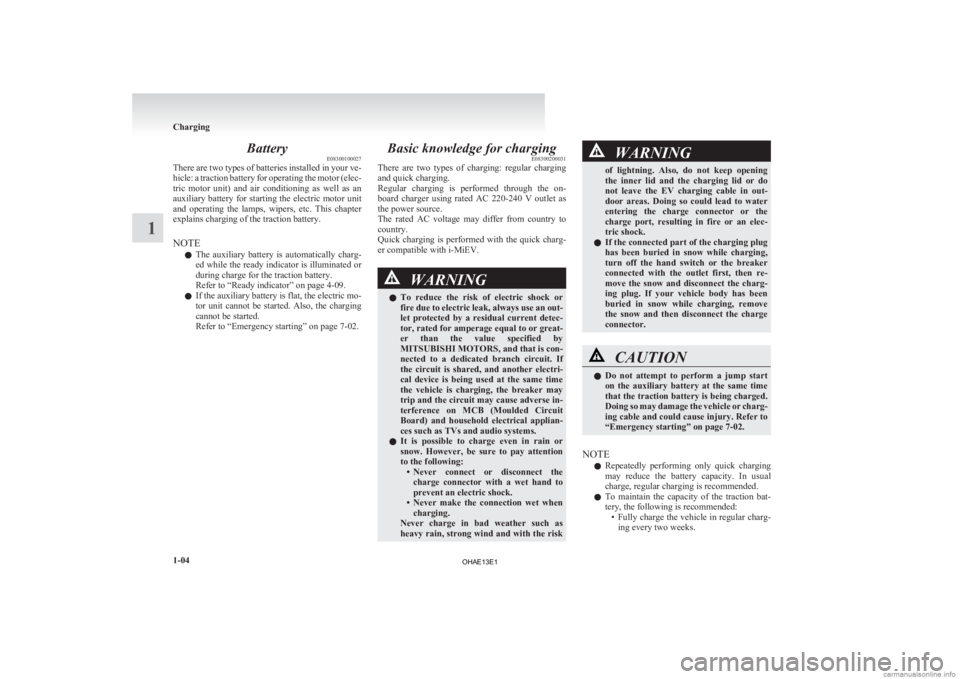
Battery
E08300100027
There
are two types of batteries installed in your ve-
hicle: a traction battery for operating the motor (elec-
tric motor unit) and air conditioning as well as an
auxiliary battery for starting the electric motor unit
and operating the lamps, wipers, etc. This chapter
explains charging of the traction battery.
NOTE
l The auxiliary battery is automatically charg-
ed while the ready indicator is illuminated or
during charge for the traction battery.
Refer to “Ready indicator” on page 4-09.
l If the auxiliary battery is flat, the electric mo-
tor unit cannot be started. Also, the charging
cannot be started.
Refer to “Emergency starting” on page 7-02. Basic knowledge for charging
E08300200031
There
are two types of charging: regular charging
and quick charging.
Regular charging is performed through the on-
board charger using rated AC 220-240 V outlet as
the power source.
The rated AC voltage may differ from country to
country.
Quick charging is performed with the quick charg-
er compatible with i-MiEV. WARNING
l To
reduce the risk of electric shock or
fire due to electric leak, always use an out-
let protected by a residual current detec-
tor, rated for amperage equal to or great-
er than the value specified by
MITSUBISHI MOTORS, and that is con-
nected to a dedicated branch circuit. If
the circuit is shared, and another electri-
cal device is being used at the same time
the vehicle is charging, the breaker may
trip and the circuit may cause adverse in-
terference on MCB (Moulded Circuit
Board) and household electrical applian-
ces such as TVs and audio systems.
l It is possible to charge even in rain or
snow. However, be sure to pay attention
to the following:
• Never connect or disconnect thecharge connector with a wet hand to
prevent an electric shock.
• Never make the connection wet when charging.
Never charge in bad weather such as
heavy rain, strong wind and with the risk WARNING
of lightning. Also, do not keep opening
the
inner lid and the charging lid or do
not leave the EV charging cable in out-
door areas. Doing so could lead to water
entering the charge connector or the
charge port, resulting in fire or an elec-
tric shock.
l If the connected part of the charging plug
has been buried in snow while charging,
turn off the hand switch or the breaker
connected with the outlet first, then re-
move the snow and disconnect the charg-
ing plug. If your vehicle body has been
buried in snow while charging, remove
the snow and then disconnect the charge
connector. CAUTION
l
Do
not attempt to perform a jump start
on the auxiliary battery at the same time
that the traction battery is being charged.
Doing so may damage the vehicle or charg-
ing cable and could cause injury. Refer to
“Emergency starting” on page 7-02.
NOTE l Repeatedly
performing only quick charging
may reduce the battery capacity. In usual
charge, regular charging is recommended.
l To maintain the capacity of the traction bat-
tery, the following is recommended:
• Fully charge the vehicle in regular charg-ing every two weeks. Charging
1-04
1
OHAE13E1
Page 27 of 258
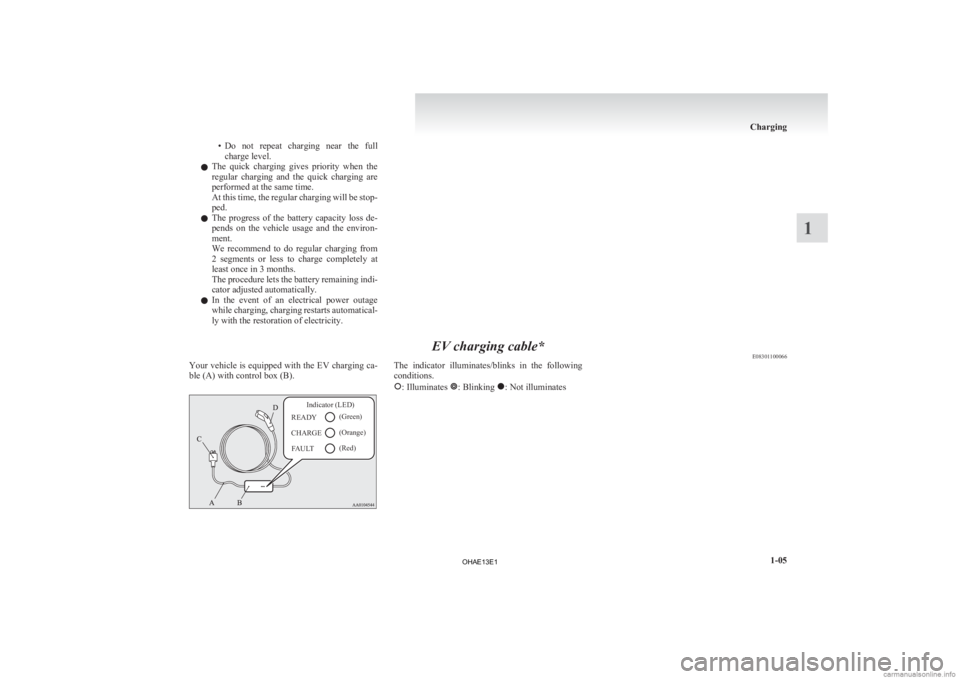
• Do not repeat charging near the full
charge level.
l The quick charging gives priority when the
regular charging and the quick charging are
performed at the same time.
At this time, the regular charging will be stop-
ped.
l The progress of the battery capacity loss de-
pends on the vehicle usage and the environ-
ment.
We recommend to do regular charging from
2 segments or less to charge completely at
least once in 3 months.
The procedure lets the battery remaining indi-
cator adjusted automatically.
l In the event of an electrical power outage
while charging, charging restarts automatical-
ly with the restoration of electricity.
EV charging cable* E08301100066
Your vehicle is equipped with the EV charging ca-
ble (A) with control box (B).
Indicator (LED)
(Green)
(Orange) (Red)
READY
CHARGE
FAULT The indicator illuminates/blinks in the following
conditions.
: Illuminates : Blinking : Not illuminates Charging
1-05 1
OHAE13E1
Page 28 of 258
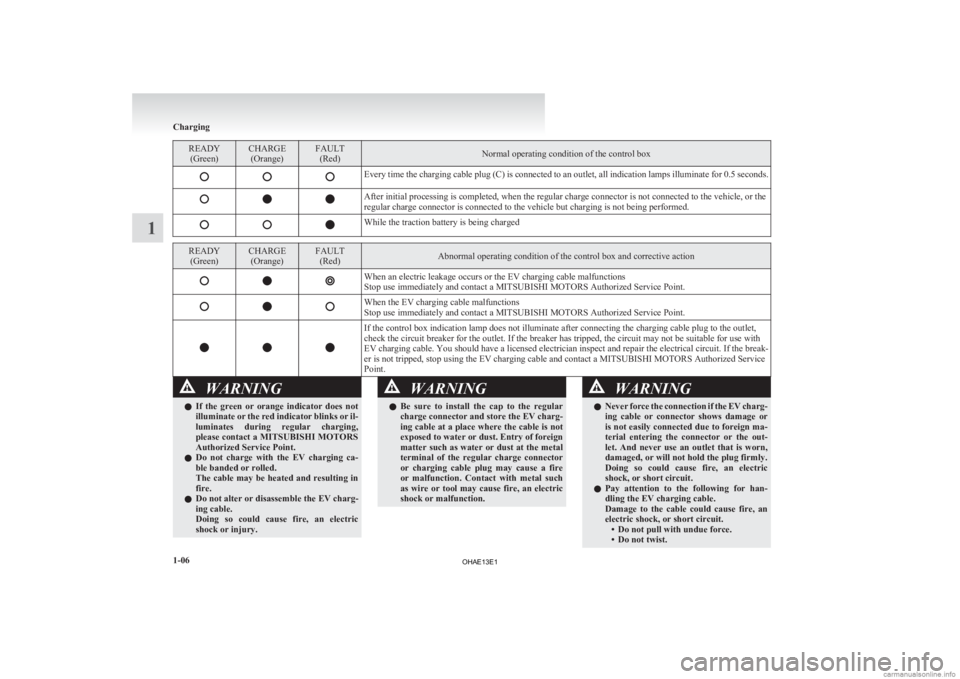
READY
(Green) CHARGE
(Orange) FAULT
(Red) Normal operating condition of the control box
Every time the charging cable plug (C) is connected to an outlet, all indication lamps illuminate for 0.5 seconds.
After initial processing is completed, when the regular charge connector is not connected to the vehicle, or the
regular charge connector is connected to the vehicle but charging is not being performed.
While the traction battery is being charged
READY
(Green) CHARGE
(Orange) FAULT
(Red) Abnormal operating condition of the control box and corrective action
When an electric leakage occurs or the EV charging cable malfunctions
Stop use immediately and contact a
MITSUBISHI MOTORS Authorized Service Point. When the EV charging cable malfunctions
Stop use immediately and contact a
MITSUBISHI MOTORS Authorized Service Point. If the control box indication lamp does not illuminate after connecting the charging cable plug to the outlet,
check the circuit breaker for the outlet. If the breaker has tripped, the circuit may not be suitable for use with
EV charging cable. You should have a licensed electrician inspect and repair the electrical circuit. If the break-
er is not tripped, stop using the EV charging cable and contact a
MITSUBISHI MOTORS Authorized Service
Point. WARNING
l If
the green or orange indicator does not
illuminate or the red indicator blinks or il-
luminates during regular charging,
please contact a MITSUBISHI MOTORS
Authorized Service Point.
l Do not charge with the EV charging ca-
ble banded or rolled.
The cable may be heated and resulting in
fire.
l Do not alter or disassemble the EV charg-
ing cable.
Doing so could cause fire, an electric
shock or injury. WARNING
l Be sure to install the cap to the regular
charge connector and store the EV charg-
ing cable at a place where the cable is not
exposed to water or dust. Entry of foreign
matter such as water or dust at the metal
terminal of the regular charge connector
or charging cable plug may cause a fire
or malfunction. Contact with metal such
as wire or tool may cause fire, an electric
shock or malfunction. WARNING
l Never force the connection if the EV charg-
ing cable or connector shows damage or
is not easily connected due to foreign ma-
terial entering the connector or the out-
let. And never use an outlet that is worn,
damaged, or will not hold the plug firmly.
Doing so could cause fire, an electric
shock, or short circuit.
l Pay attention to the following for han-
dling the EV charging cable.
Damage to the cable could cause fire, an
electric shock, or short circuit.
• Do not pull with undue force.
• Do not twist. Charging
1-06
1
OHAE13E1
Page 29 of 258
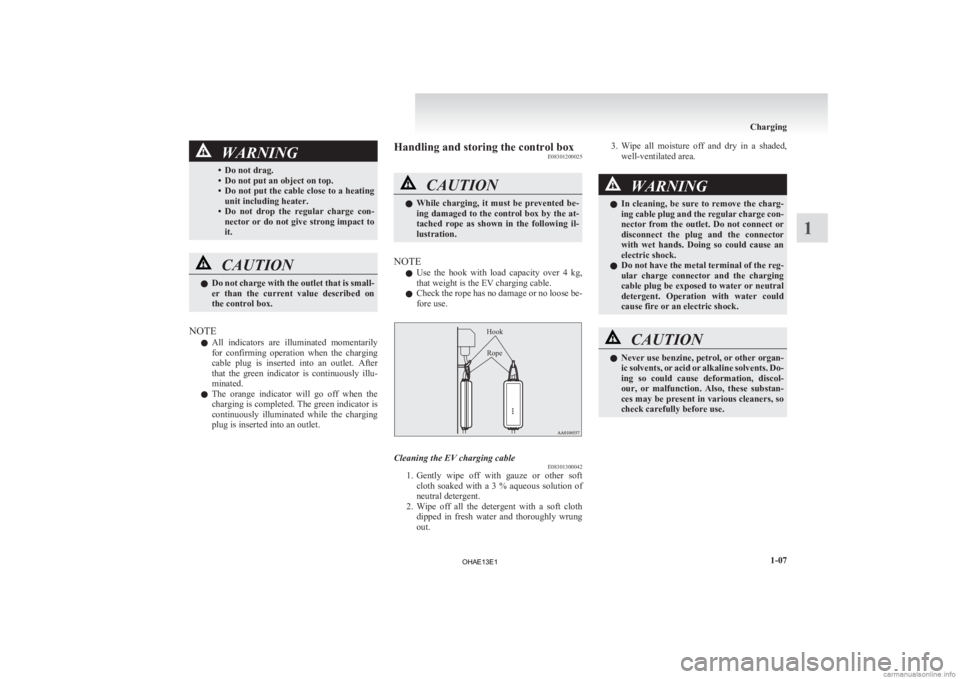
WARNING
• Do not drag.
• Do not put an object on top.
• Do not put the cable close to a heating unit including heater.
• Do not drop the regular charge con- nector or do not give strong impact to
it. CAUTION
l
Do
not charge with the outlet that is small-
er than the current value described on
the control box.
NOTE l All
indicators are illuminated momentarily
for confirming operation when the charging
cable plug is inserted into an outlet. After
that the green indicator is continuously illu-
minated.
l The orange indicator will go off when the
charging is completed. The green indicator is
continuously illuminated while the charging
plug is inserted into an outlet. Handling and storing the control box
E08301200025 CAUTION
l
While
charging, it must be prevented be-
ing damaged to the control box by the at-
tached rope as shown in the following il-
lustration.
NOTE l Use
the hook with load capacity over 4 kg,
that weight is the EV charging cable.
l Check the rope has no damage or no loose be-
fore use.
Hook
Rope Cleaning the EV charging cable
E08301300042
1. Gently
wipe off with gauze or other soft
cloth soaked with a 3 % aqueous solution of
neutral detergent.
2. Wipe off all the detergent with a soft cloth dipped in fresh water and thoroughly wrung
out. 3. Wipe
all moisture off and dry in a shaded,
well-ventilated area. WARNING
l In
cleaning, be sure to remove the charg-
ing cable plug and the regular charge con-
nector from the outlet. Do not connect or
disconnect the plug and the connector
with wet hands. Doing so could cause an
electric shock.
l Do not have the metal terminal of the reg-
ular charge connector and the charging
cable plug be exposed to water or neutral
detergent. Operation with water could
cause fire or an electric shock. CAUTION
l
Never use benzine, petrol, or other organ-
ic
solvents, or acid or alkaline solvents. Do-
ing so could cause deformation, discol-
our, or malfunction. Also, these substan-
ces may be present in various cleaners, so
check carefully before use. Charging
1-07 1
OHAE13E1
Page 30 of 258
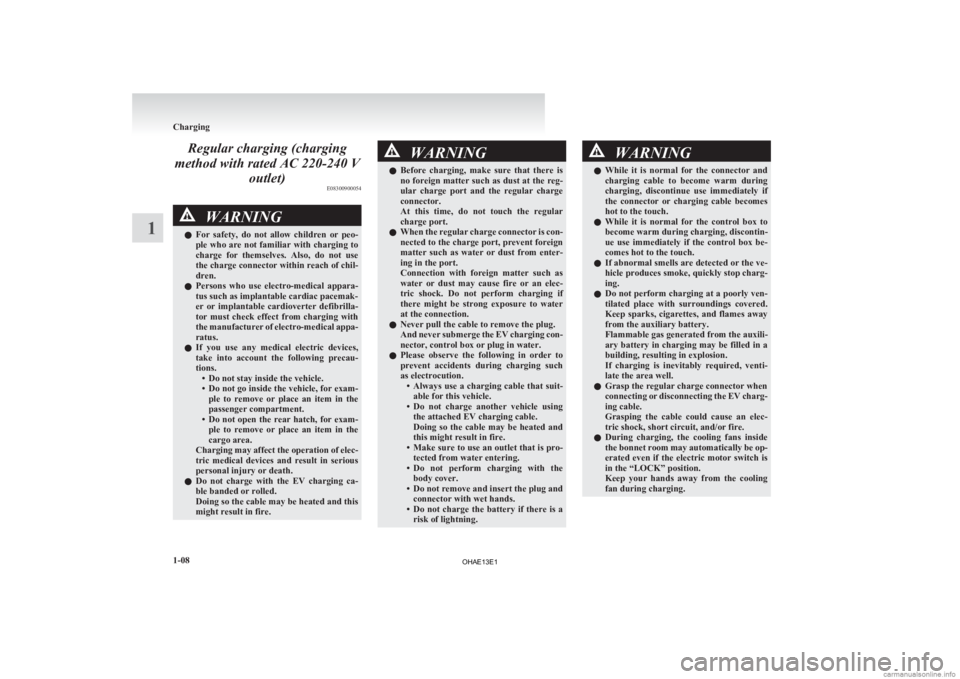
Regular charging (charging
method with rated AC 220-240 V outlet) E08300900054WARNING
l For safety, do not allow children or peo-
ple who are not familiar with charging to
charge for themselves. Also, do not use
the charge connector within reach of chil-
dren.
l Persons who use electro-medical appara-
tus such as implantable cardiac pacemak-
er or implantable cardioverter defibrilla-
tor must check effect from charging with
the manufacturer of electro-medical appa-
ratus.
l If you use any medical electric devices,
take into account the following precau-
tions.
• Do not stay inside the vehicle.
• Do not go inside the vehicle, for exam-ple to remove or place an item in the
passenger compartment.
• Do not open the rear hatch, for exam- ple to remove or place an item in the
cargo area.
Charging may affect the operation of elec-
tric medical devices and result in serious
personal injury or death.
l Do not charge with the EV charging ca-
ble banded or rolled.
Doing so the cable may be heated and this
might result in fire. WARNING
l Before
charging, make sure that there is
no foreign matter such as dust at the reg-
ular charge port and the regular charge
connector.
At this time, do not touch the regular
charge port.
l When the regular charge connector is con-
nected to the charge port, prevent foreign
matter such as water or dust from enter-
ing in the port.
Connection with foreign matter such as
water or dust may cause fire or an elec-
tric shock. Do not perform charging if
there might be strong exposure to water
at the connection.
l Never pull the cable to remove the plug.
And never submerge the EV charging con-
nector, control box or plug in water.
l Please observe the following in order to
prevent accidents during charging such
as electrocution.
• Always use a charging cable that suit-able for this vehicle.
• Do not charge another vehicle using the attached EV charging cable.
Doing so the cable may be heated and
this might result in fire.
• Make sure to use an outlet that is pro- tected from water entering.
• Do not perform charging with the body cover.
• Do not remove and insert the plug and connector with wet hands.
• Do not charge the battery if there is a risk of lightning. WARNING
l While it is normal for the connector and
charging cable to become warm during
charging, discontinue use immediately if
the connector or charging cable becomes
hot to the touch.
l While it is normal for the control box to
become warm during charging, discontin-
ue use immediately if the control box be-
comes hot to the touch.
l If abnormal smells are detected or the ve-
hicle produces smoke, quickly stop charg-
ing.
l Do not perform charging at a poorly ven-
tilated place with surroundings covered.
Keep sparks, cigarettes, and flames away
from the auxiliary battery.
Flammable gas generated from the auxili-
ary battery in charging may be filled in a
building, resulting in explosion.
If charging is inevitably required, venti-
late the area well.
l Grasp the regular charge connector when
connecting or disconnecting the EV charg-
ing cable.
Grasping the cable could cause an elec-
tric shock, short circuit, and/or fire.
l During charging, the cooling fans inside
the bonnet room may automatically be op-
erated even if the electric motor switch is
in the “LOCK” position.
Keep your hands away from the cooling
fan during charging. Charging
1-08
1
OHAE13E1